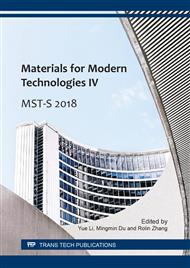[1]
Jie Li, Gang Zhang, Yan-qing Lai, Densification and sintering dynamics of 10NiO-NiFe2O4, composites doped with CaO, J. Journal of Central South University. 14 (2007) 629-632.
DOI: 10.1007/s11771-007-0120-2
Google Scholar
[2]
R. P. Pawlek, Inert Anodes: An Update, in: D. H. DeYoung, Light Metals, TMS., Warrendale, 2008, p.1039–1045.
Google Scholar
[3]
Zhou K C, Tao Y Q, Research development of nickel ferrite based cermet inert anode materials, J. Chinese Journal of Nonferrous Metals. 21 (2011) 2418-2429.
Google Scholar
[4]
Yang Wen‐jie, Guo Jie, Li Jing, A self‐repairing cermet anode: Preparation and corrosion behavior of (Cu–Ni–Fe)/NiFe2O4 cermet with synergistic action, J. Journal of the American Ceramic Society, 100 (2016).
DOI: 10.1111/jace.14622
Google Scholar
[5]
Yang Wen-jie, He Liu-qing, Li Jing, Zheng Xin, Zhou Ke-chao, Effect of MnO addition on inert anodes of 40(50Cu-Ni)-(NiFe2O4-10NiO) cermet, J. Journal of Synthetic Crystals. 46 (2017) 178-182(in Chinese).
Google Scholar
[6]
Zhong-liang TIAN, Wei-chang GUO, Yan-qing LAI, Kai ZHANG, Jie LI, Effect of sintering atmosphere on corrosion resistance of Ni/(NiFe2O4-10NiO) cermet inert anode for aluminum electrolysis, J. Transactions of Nonferrous Metals Society of China. 26 (2016).
DOI: 10.1016/s1003-6326(16)64422-9
Google Scholar
[7]
Long Xiu-li, Study on corrosion behavior in molten salt and mechanical properties of NiFe2O4-based inert anode. Northeastern University, 2014 (in Chinese).
Google Scholar
[8]
ZS Hua, GC Yao, XL Long, HC Wang, Z Zhao, Selection of fiber reinforcement for NiFe2O4-based inert anode materials in aluminum electrolysis, J. Chinese Journal of Nonferrous Metals, 23 (2013) 154-161.
Google Scholar
[9]
Zhang Ya-nan, Study on the dissolution process of alumina in NaF-AlF3 based electrolyte. University of Science & Technology Beijing, 2015 (in Chinese).
Google Scholar
[10]
Zheng Xin, Qin Qing-wei, Yang Jian-hong, Liu Ying, Guo Jie, Corrosion behavior of Fe element in NiFe2O4-10NiO based cermet anode for aluminum electrolysis under low temperature electrolysis, J. Journal of Wuhan University of Science and Technology. 39 (2016).
Google Scholar
[11]
T. R. Alcorn, A. T. Tabereaux, N. E. Richards, C. F. Windisch, D. M. Strachan, J. S. Gregg, and M. S. Frederick, Operational Results of Pilot Cell Test with Cermet Inert, Anodes, in: M. B. Christian, Light Metals. TMS., Warrendale, 1993, p.433.
DOI: 10.2172/6231844
Google Scholar
[12]
Tian Z L, Lai Y Q, Li Z, Cup-shaped functionally gradient NiFe2O4-based cermet inert anodes for aluminum reduction, J. JOM.61 (2009) 34-38.
DOI: 10.1007/s11837-009-0067-x
Google Scholar
[13]
Zhou KC, Li ZY, Zhang L, The Cermet Inert Anode Materials for Aluminum Electrolysis., The Press of Central South University, Changsha, (2012).
Google Scholar
[14]
Ti GC, Wang YZ, Molecular dynamics simulation study on the effect of AlF3 on the structure and properties of cryolite molten salt system, J. Journal of Kunming University of Science and Technology (NATURAL SCIENCE EDITION).3 (2015).
Google Scholar
[15]
Hu XW, Wang ZW, Chen GH, Lu GM, Cui JZ, Cao XZ, Raman spectra of NaF-AlF3 molten salt ion structure, J. The Chinese Journal of Nonferrous Metals. 18 (2008) 1914-1919 (in Chinese).
Google Scholar
[16]
Xiao L, You JL, Jiang GC, Study on the micro environment and Raman Spectra Characterization of ionic clusters of Fluor aluminate, J. The Chinese Journal of Nonferrous Metals. 18 (2008) 1164−1170(in Chinese).
Google Scholar
[17]
Zhao T, You JL, Wang YY, Wang L, Ma L, Raman spectroscopic characterization and quantum chemical ab initio calculation of the structure of NaF-AlF3 two element system aluminum fluoride tetrahedron cluster, J. Journal of light scattering. 24 (2012).
Google Scholar
[18]
Xiaowei Liu, Jinglin You, Yuanyuan Wang, Computational simulation and high temperature Raman spectroscopy of Na3AlF6-Al2O3 system molten salt structure, J. The Chinese Journal of Nonferrous Metals. 1 (2014) 286-292 (in Chinese).
Google Scholar
[19]
Ma Nan, You Jing-lin, Lv Xiu-mei, Wang Jian, Wang Min, Wei Guang-chao, High temperature Raman Spectroscopic Study on the structure of Na3AlF6-Al2O3 molten salt system, National Conference on Light Scattering, 2015 (in Chinese).
Google Scholar


